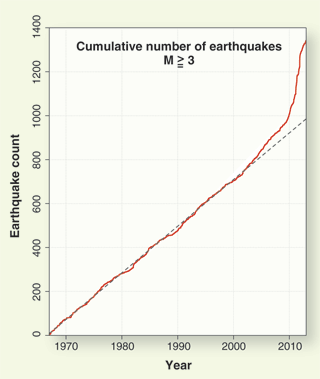Since several years now, Sincedutch = Dutchsinse reports on earthquakes related to fracking and oil drilling among other subjects. Now, in this week issue of Science Magazine, four different scientific articles corroborate the findings of Sincedutch (which actually were thought to be nonesense by many), showing that fracking produce small too medium tremors. Well, I think the map I published two 2 days ago was a great beginning to open this discussion on the strange and bad consequences of fracking.
Follow us: Facebook and Twitter
As introduction to these articles, William L. Ellsworth writes:
Human-induced earthquakes have become an important topic of political and scientific discussion, owing to the concern that these events may be responsible for widespread damage and an overall increase in seismicity. It has long been known that impoundment of reservoirs, surface and underground mining, withdrawal of fluids and gas from the subsurface, and injection of fluids into underground formations are capable of inducing earthquakes. In particular, earthquakes caused by injection have become a focal point, as new drilling and well-completion technologies enable the extraction of oil and gas from previously unproductive formations.
Earthquakes with magnitude (M) ≥ 3 in the U.S. midcontinent, 1967–2012. After decades of a steady earthquake rate (average of 21 events/year), activity increased starting in 2001 and peaked at 188 earthquakes in 2011. Human-induced earthquakes are suspected to be partially responsible for the increase.
Advances
Microearthquakes (that is, those with magnitudes below 2) are routinely produced as part of the hydraulic fracturing (or “fracking”) process used to stimulate the production of oil, but the process as currently practiced appears to pose a low risk of inducing destructive earthquakes. More than 100,000 wells have been subjected to fracking in recent years, and the largest induced earthquake was magnitude 3.6, which is too small to pose a serious risk. Yet, wastewater disposal by injection into deep wells poses a higher risk, because this practice can induce larger earthquakes. For example, several of the largest earthquakes in the U.S. midcontinent in 2011 and 2012 may have been triggered by nearby disposal wells. The largest of these was a magnitude 5.6 event in central Oklahoma that destroyed 14 homes and injured two people. The mechanism responsible for inducing these events appears to be the well-understood process of weakening a preexisting fault by elevating the fluid pressure. However, only a small fraction of the more than 30,000 wastewater disposal wells appears to be problematic—typically those that dispose of very large volumes of water and/or communicate pressure perturbations directly into basement faults.Follow us: Facebook and Twitter
Outlook
Injection-induced earthquakes, such as those that struck in 2011, clearly contribute to the seismic hazard. Quantifying their contribution presents difficult challenges that will require new research into the physics of induced earthquakes and the potential for inducing large-magnitude events. The petroleum industry needs clear requirements for operation, regulators must have a solid scientific basis for those requirements, and the public needs assurance that the regulations are sufficient and are being followed. The current regulatory frameworks for wastewater disposal wells were designed to protect potable water sources from contamination and do not address seismic safety. One consequence is that both the quantity and timeliness of information on injection volumes and pressures reported to regulatory agencies are far from ideal for managing earthquake risk from injection activities. In addition, seismic monitoring capabilities in many of the areas in which wastewater injection activities have increased are not capable of detecting small earthquake activity that may presage larger seismic events.
via Injection-Induced Earthquakes.
Follow us: Facebook and Twitter
The three other related articles are enumerated below with their respective abstracts:
Anthropogenic Seismicity Rates and Operational Parameters at the Salton Sea Geothermal Field by Emily E. Brodsky and Lia J. Lajoie
Geothermal power is a growing energy source; however, efforts to increase production are tempered by concern over induced earthquakes. Although increased seismicity commonly accompanies geothermal production, induced earthquake rate cannot currently be forecast based on fluid injection volumes or any other operational parameters. We show that at the Salton Sea Geothermal Field, the total volume of fluid extracted or injected tracks the long-term evolution of seismicity. After correcting for the aftershock rate, the net fluid volume (extracted-injected) provides the best correlation with seismicity in recent years. We model the background earthquake rate with a linear combination of injection and net production rates that allows us to track the secular development of the field as the number of earthquakes per fluid volume injected decreases over time.
Enhanced Remote Earthquake Triggering at Fluid-Injection Sites in the Midwestern United States by Nicholas J. van der Elst, Heather M. Savage, Katie M. Keranen, and Geoffrey A. Abers
A recent dramatic increase in seismicity in the midwestern United States may be related to increases in deep wastewater injection. Here, we demonstrate that areas with suspected anthropogenic earthquakes are also more susceptible to earthquake-triggering from natural transient stresses generated by the seismic waves of large remote earthquakes. Enhanced triggering susceptibility suggests the presence of critically loaded faults and potentially high fluid pressures. Sensitivity to remote triggering is most clearly seen in sites with a long delay between the start of injection and the onset of seismicity and in regions that went on to host moderate magnitude earthquakes within 6 to 20 months. Triggering in induced seismic zones could therefore be an indicator that fluid injection has brought the fault system to a critical state.
Some Earthquakes Warn That They Are About to Strike by Richard A. Kerr
The bad news that injecting wastewater deep into the crust can set off earthquakes has now been leavened by a bit of good news. In the past few years, the frequency of moderate-sized earthquakes has surged in the central United States and other areas where wastewater from “fracking” for gas and oil is pumped into the deep earth for disposal. Now, seismologists have found that some of the largest quakes induced by deep injection are preceded by a warning sign: a swarm of smaller tremors.













[…] is indeed no longer a matter of debate that hydraulic fracturing of oil and gas wells, or fracking, causes earthquakes. And thus, there are no doubts that this increase of bills for the normal US citizens are linked to […]
[…] A May 31, 2014 earthquake registered at 3.4 on the Richter scale and was felt across that same area of Weld County. That shaker, at nearly 8,000 meters below the surface, rekindled a debate over oil and gas activity’s impact on earthquakes. […]
[…] data suggests the current fracking boom is a major part of the quakes’ spike. Fracking has long been associated with seismic activity, as researchers have shown connections […]
[…] Strange Sounds – Four Studies Demonstrate That Fracking and Geothermal Power Produce Earthquakes […]